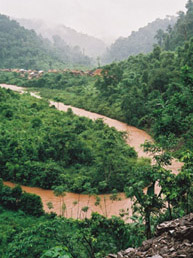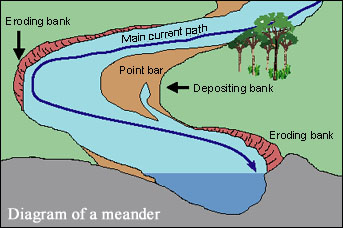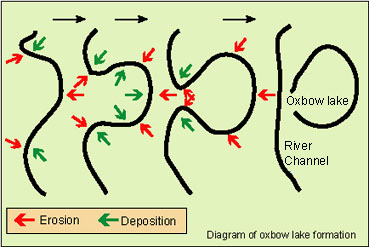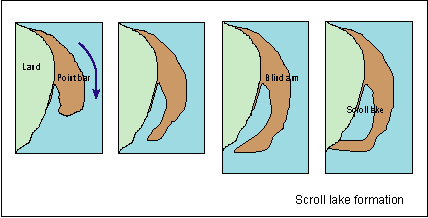Lowland Rivers--
The slope of lowland rivers is usually extremely low and the water level
may fall only a few centimetres over many kilometres. The landscape is
usually very flat and the floodplain may cover very large areas.
The Channel
In the lower reaches of the river where the slope of the landscape is
low, sediments are much finer ranging from sands to fine mud. This zone
is influenced mainly by deposition, but there is also localized erosion
with local reworking of the sediments.
 The
main channel or channels of the river form a sinuous path across the landscape,
known as meandering. The channel may be single or may split into sub-branches
to form a braided pattern. Individual meander bends are constantly changing
shape by erosion and deposition. Each bend has a deep outer portion where
rapid current erodes and undercuts the bank. On the inside of the bend,
sediment is deposited to form a shallow beach known as a point bar.
The
main channel or channels of the river form a sinuous path across the landscape,
known as meandering. The channel may be single or may split into sub-branches
to form a braided pattern. Individual meander bends are constantly changing
shape by erosion and deposition. Each bend has a deep outer portion where
rapid current erodes and undercuts the bank. On the inside of the bend,
sediment is deposited to form a shallow beach known as a point bar.
Erosion processes are slowed where the river banks are heavily vegetated
or even forested as the roots of the plants bind the soil and defend against
the action of waves. Standing vegetation, such as reeds, rapidly colonizes
point bars. The plants further slow the flow and accelerated deposition
of silt.
As erosion continues the meander bend increases in size until it doubles
back on itself, and eventually cuts through to leave an oxbow.
On the inside of the bend successive deposition of point bars and the
isolation of small dead arms leave behind scroll lakes.
 |
 |
 |
The erosion of material from the outside of a bend and
deposition on the inside means that meanders tend to move downstream and
cut across the floodplain laterally over time. The lateral movement of
the river over a scale of decades or even centuries affects land tenure,
and there are frequently pressures to stabilize the river in the interests
of land ownership.
Meanders create a range of habitats. Larger fish use the deeper portions
at the outside of the bends as resting areas. Some fish use the shallow
sandy beaches of the point bars for spawning and the slack waters of the
bays at the downstream ends of the bars provide nursery areas for juvenile
fish.
River banks are usually lined with emergent and floating vegetation that
provides living space for young aquatic organisms and the adults of many
small species. Riparian forests are also common and attract other species
in search of shade, shelter and breeding areas.